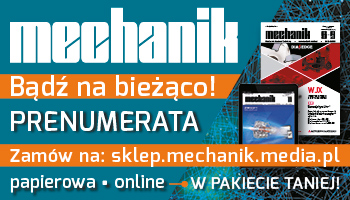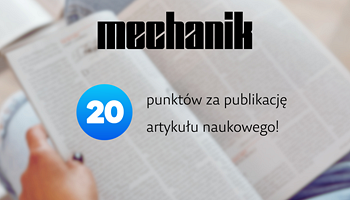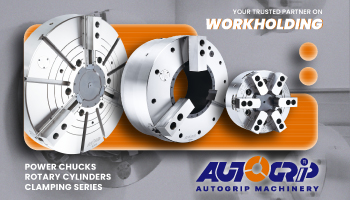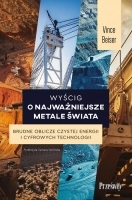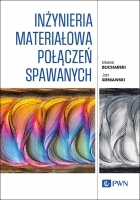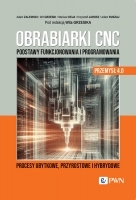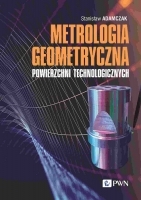Stress relaxation in samples made of acrylonitrile butadiene styrene material manufactured by fused deposition modelling
Relaksacja naprężeń w próbkach wykonanych z akrylonitrylu-butadienu-styrenu wytworzonych metodą FDM *
Mechanik nr 12/2021 - Druk 3D
ABSTRACT: Increased interest in fused deposition modeling (FDM) resulting, for example, from its use in the production of utility models determines the undertaking of research on mechanical and rheological properties of materials. Mechanical and rheological properties of models made of materials used in FDM technology depend on technological parameters. In this paper, the effect of 0° and 90° print orientation on stress relaxation was analyzed. Additionally, the usefulness of the rheological model to describe the relaxation curve was evaluated. Stress relaxation tests were performed by tensile testing. The five-parameter Maxwell-Wiechert model was used to describe stress relaxation. The tests showed little effect of print orientation on the rheological parameters of the five-parameter model. The Maxwell-Wiechert model showed a very good approximation to the stress relaxation curves.
KEYWORDS: stress relaxation, ABS, FDM technology, 3D printing
STRESZCZENIE: Wzrost zainteresowania technologią osadzania topionego materiału (FDM), wynikający m.in. z zastosowania jej do produkcji modeli użytkowych, wymusza podjęcie badań nad właściwościami mechanicznymi w tym reologicznymi materiałów. Właściwości mechaniczne (i reologiczne) modeli wytwarzanych z materiałów stosowanych w technologii FDM zależą od parametrów technologicznych. W prezentowanym artykule poddano analizie wpływ orientacji wydruku 0° i 90° na relaksację naprężeń. Dodatkowo oceniono przydatność modelu reologicznego do opisu krzywej relaksacji. Testy relaksacji naprężeń wykonano poprzez próbę rozciągania. Do opisu relaksacji naprężeń zastosowano pięcioparametrowy model Maxwella-Wiecherta. Badania wykazały niewielki wpływ orientacji wydruku na parametry reologiczne modelu pięcioparametrowego. Model Maxwella-Wiecherta wykazał bardzo dobrą aproksymację do krzywych relaksacji naprężeń.
SŁOWA KLUCZOWE: relaksacja naprężeń, ABS, technologia FDM, druk 3D
BIBLIOGRAFIA / BIBLIOGRAPHY:
[1] Suárez L., Domínguez M. “Sustainability and environmental impact of fused deposition modelling (FDM) technologies”. Int. J. Adv. Manuf. Technol. 106 (2020): 1267–1279, https://doi.org/10.1007/S00170-019-04676-0.
[2] Górski F., Kuczko W., Wichniarek R., Hamrol A. “Mechanical properties of composite parts manufactured in FDMtechnology”. Rapid Prototyp. J. 24 (2018): 1281–1287,https://doi.org/10.1108/RPJ-11-2016-0197.
[3] Balyakin A.V., Vdovin R.A., Kyarimov R.R. “Study of FDMtechnology applications in the casting production of GTEdetails”. IOP Conf. Ser. Mater. Sci. Eng. 971 (2020), https://doi.org/10.1088/1757-899X/971/2/022003.
[4] Sanchez Ramirez A., Islán Marcos M.E., Blaya Haro F.,D’Amato R., Sant R., Porras J. “Application of FDM technology to reduce aerodynamic drag”. Rapid Prototyp. J.25 (2019): 781–791, https://doi.org/10.1108/RPJ-09-2018-0251.
[5] Yadav D.K., Srivastava R., Dev S. “Design & fabricationof ABS part by FDM for automobile application”. Mater. Today Proc. 26 (2019): 2089–2093, https://doi.org/10.1016/J.MATPR.2020.02.451.
[6] Samykano M., Selvamani S.K., Kadirgama K., Ngui W.K.,Kanagaraj G., Sudhakar K. “Mechanical property of FDMprinted ABS: influence of printing parameters”. Int. J.Adv. Manuf. Technol. 102 (2019): 2779–2796, https://doi.org/10.1007/S00170-019-03313-0.
[7] Cantrell J.T., Rohde S., Damiani D., Gurnani R., DiSandroL., Anton J., Young A., Jerez A., Steinbach D., Kroese C.,et al. “Experimental characterization of the mechanicalproperties of 3D-printed ABS and polycarbonate parts”.Rapid Prototyp. J. 23 (2017): 811–824, https://doi.org/10.1108/RPJ-03-2016-0042.
[8] Rajesh N., Guru Mahesh G., Venkataramaiah P. “Study ofMachining Parameters on Tensile strength and Surfaceroughness of ABS samples printed by FDM”. Adv. Mater. Process. Technol. (2021), https://doi.org/10.1080/2374068X.2021.1946758.
[9] Wichniarek R., Hamrol A., Kuczko W., Górski F., Rogalewicz M. “ABS filament moisture compensation possibilities in the FDM process. CIRP J. Manuf. Sci. Technol.35 (2021): 550–559, https://doi.org/10.1016/J.CIRPJ.2021.08.011.
[10] Wu W., Geng P., Li G., Zhao D., Zhang H., Zhao J. “Influence of layer thickness and raster angle on the mechanical properties of 3D-printed PEEK and a comparativemechanical study between PEEK and ABS”. Materials(Basel). 8 (2015): 5834–5846, https://doi.org/10.3390/MA8095271.
[11] Kozior T. “Rheological properties of polyamide pa 2200in sls technology”. Teh. Vjesn. 27 (2020): 1092–1100,https://doi.org/10.17559/TV-20190225122204.
[12] Bochnia J., Blasiak S. “Stress relaxation and creep ofa polymer-aluminum composite produced through selective laser sintering”. Polymers (Basel). 12 (2020), https://doi.org/10.3390/POLYM12040830.
[13] Mohamed O.A., Masood S.H., Bhowmik J.L. “Optimization of fused deposition modeling process parameters:a review of current research and future prospects”.Adv. Manuf. 3 (2015): 42–53, https://doi.org/10.1007/S40436-014-0097-7.
[14] Gebisa A.W., Lemu H.G. “Investigating effects of Fused-deposition modeling (FDM) processing parameters onflexural properties of ULTEM 9085 using designed experiment”. Materials (Basel). 11 (2018), https://doi.org/10.3390/MA11040500.
[15] Bochnia J. Wybrane właściwości fizyczne materiałów kształtowanych technologiami przyrostowymi (in English–Selected physical properties of materials obtained withadditive technologies), (2018), ISBN 978-83-65719-36-2.
DOI: https://doi.org/10.17814/mechanik.2021.12.16
* Artykuł recenzowany




